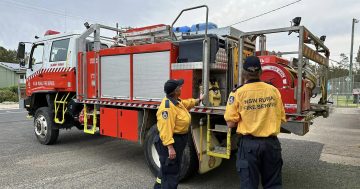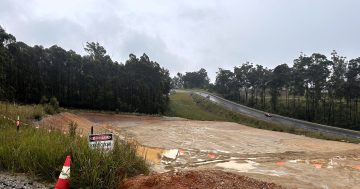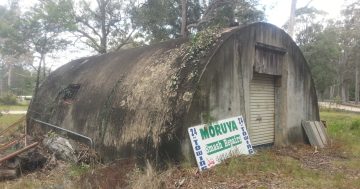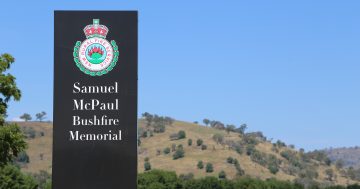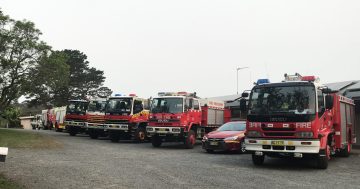
Moruya skies yesterday afternoon (23 January). Photo: Alex Rea.
For the third time in the last month, Moruya has braced for survival as bushfires raged around the township. And while this was the closest shave yet, the town is still standing after a concerted battle late yesterday when the blaze hit its western outskirts.
The Clyde Mountain fire came within 150 metres of the Moruya Hospital and within three streets of the fire control centre in Campbell Street.
“I’ll be honest, we had units outside to defend the building so we could continue to manage the incident,” RFS spokesperson Kelwyn White said.
“It was impacting the entire community, even those who were trying to defend it.”
Winds gusting close to 100 km/h, described by Region Media’s journalists in Moruya as “diabolical”, fed the blaze as it poured out of the Deua Valley along Araluen Rd, crossing the river at Yarragee. The blaze circled around Moruya to the west, moved towards Wamban, and was pushed back towards Moruya as the southerly arrived.
Region Media journalists described a series of loud bangs, large plumes of smoke and a vivid orange sky in town as firefighters battled to save houses on the town’s western edge around Riverwood Place.
“Thank goodness for our local firies, they saved our hospital,” said Moruya Waterside Hotel publican Mark Ethell on social media. “Heaven help what could have been if the fire, which was so damn close, took hold of the hospital – thank you”.
Kelwyn White said that although the southerly was not strong, conditions nevertheless eased as it moved through and light rain began to fall on the fire ground.
“By around about 11:00 pm last night our fires had gone back to watch and act and then advice. The biggest thing was the reduction in wind”.
While losses have not been confirmed yet, it looks likely that around 10 homes have been lost along the Yarragee Road and Deua Valley/Araluen Road.
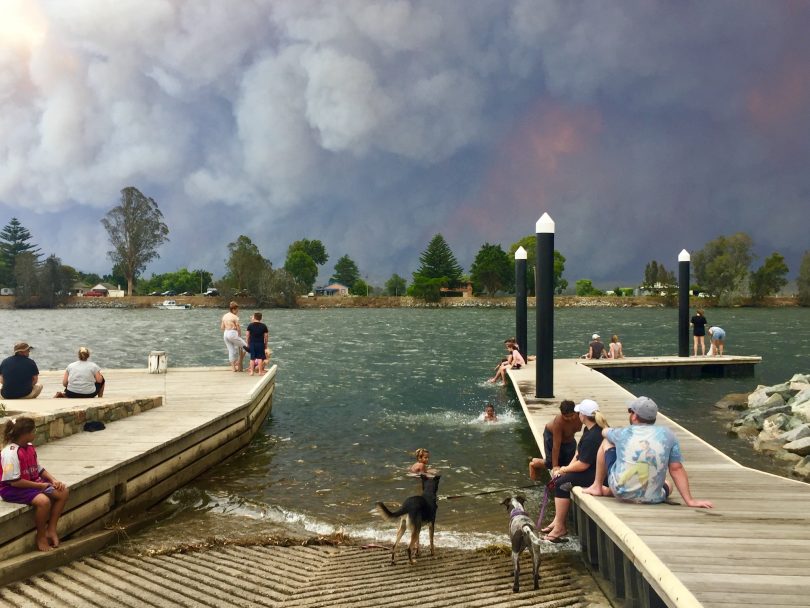
Moruya on New Year’s Eve. Photo: Lisa Herbert.
Speaking on ABC Radio Canberra this morning, Eurobodalla mayor Liz Innes said: “We’re well and truly singed around the edges, and yesterday was another harrowing and hard day for the community, particularly from Moruya south down to Tilba.”
Describing “a massive road to recovery”, the mayor said that encouraging visitors to return to communities still battling with active fires posed a dilemma. “We desperately need people to come and support our economy. There is still plenty of the shire that isn’t impacted by the fire but obviously, people do need to understand we are still dealing with an active fire and we will be dealing with this active fire through the long hot summer ahead.
“So whilst we’re saying to people ‘yes’ you can still come down’, and the Kings Highway is back open again and the Princes Highway, we’re saying be alert, be understanding, come with a whole lot of patience. It’s really important that people are respectful of those that may have lost their property.
“Thanks for the love, keep it coming. We’re going to need every ounce of love and support going forward.”
Kelwyn White agreed that the community has been under enormous stress around Moruya but has also shown great resilience.
“There are high levels of anxiety and stress in our community but on the whole people heed the warnings and are responding appropriately, whether they are relocating or actively defending themselves.
“I think yesterday serves as a stark reminder that this season is far from over. While we had a period of 10 days of easing conditions where we worked hard to secure the fires where we could, this was always an ongoing threat.”
The RFS has produced information on living with campaign fires to guide residents through coping with a prolonged onslaught, preparing themselves during quieter periods and being ready to act when fires flare.
“We’ve got a long way to go until the end of bushfire danger period,” Kelwyn said. “Control operations had restricted the fire to its existing footprint but Mother Nature had other ideas yesterday.
“The RFS Commissioner has openly stated that the only thing that will extinguish these fires are season-ending rains despite our best efforts.
“We need to remain vigilant, not complacent. The next five to seven days look favourable with lower temperatures and we’ll be really focussed on our containment lines.
“But there will be more spikes before this is over.”






